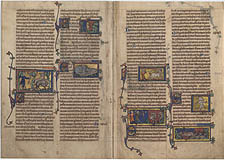The Peterborough Bestiary
![]()
This prospectus announces the forthcoming publication of the Peterborough
Bestiary. The painstaking photographic process used to reproduce the manuscript
has captured not only the text and rich decorations, but also the color
variations and stains in the original parchment.
Produced in England in about 1300, the Peterborough Bestiary features 104 vivid miniatures representing local, exotic, and mythological animals in the high Gothic style. The bestiary is so named because it is thought to have belonged to the monks of Peterborough Abbey, once one of the richest monasteries in England. The medieval library was scattered when the abbey was forced to close in the 1540s. The Bestiary was rescued by the archbishop Matthew Parker, who intrusted it in 1574 to his famous library at Corpus Christi College, Cambridge, where it still remains.
![]()
Prospectus. The Peterborough Bestiary. Lucerne:
Editions facsimilés, 2003.
![]()

Copyright
© 2002 Division of Rare & Manuscript
Collections
2B Carl A. Kroch Library, Cornell University, Ithaca, NY, 14853
Phone Number: (607) 255-3530. Fax Number: (607) 255-9524
For
reference questions, send mail to:
rareref@cornell.edu
If you have questions or comments about the site, send mail to: webmaster.
